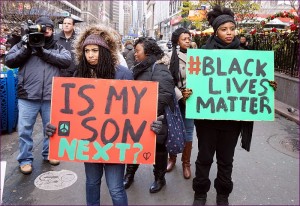 The killing of yet another unarmed black person by a white police officer is not being dismissed by local authorities as inconsequential this time around.
The killing of yet another unarmed black person by a white police officer is not being dismissed by local authorities as inconsequential this time around.
Perhaps because stark evidence left them in a no-choice situation: The shooting of South Carolina resident Walter Scott by Michael Slager was captured on video, by a passerby who recorded the shooting on his cell phone. There’s plenty of news and opinion circulating about it already, so I won’t repeat the terrible details.
Would there have been an arrest if Feidin Santana, the passerby who recorded Scott’s shooting, hadn’t served as a witness in the name of justice? We’ll never know. It remains to be seen whether the arrest will represent a turning of the tides. So the more productive question is: Where might the arrest of Slager on murder charges sit on a timeline of police accountability?
Yesterday, Black Lives Matter held a rally outside North Charleston’s city hall. While the video made it impossible for North Charleston’s leadership to deny that an injustice had occurred, the Black Lives Matter movement deserves credit for keeping injustices in the public eye, thereby influencing authorities’ words and decisions in the wake of the shooting.
As one Black Lives Matter protestor told local media: “This is a movement, not a moment.” In light of Scott’s death and the officer’s arrest, it’s worth reviewing how Black Lives Matter started and how it influences public discussions about police accountability.
The Movement’s Roots
Black Lives Matter arose in 2013, as a response to the acquittal of George Zimmerman for second-degree murder in the fatal shooting of 17 year-old Trayvon Martin. Zimmerman fatally shot Martin while on duty as a neighborhood watch volunteer in Sanford, Florida. Martin, who was African American, had been walking from a convenience store to a relative’s home when Zimmerman called the police to report a suspicious person. The police told Zimmerman not to follow the person, but he pursued the unarmed Martin. The fatal shooting, and the acquittal, sparked outrage across the U.S.
Black Lives Matter truly grew into a household name following the fatal police shooting of Michael Brown in August 2014, in Ferguson, Missouri. Like Martin, 18 year-old Brown had been unarmed. A grand jury declined to indict Darren Wilson, the white police officer who killed Brown, igniting mass protests in Ferguson as well as cities across the U.S.
#BlackLivesMatter
The Black Lives Matter hashtag is simultaneously a social media phenomenon and the rallying cry of a nonviolent movement. As a movement, #BlackLivesMatter has successfully sustained a conversation about racial injustice and police brutality in the United States.
Throughout 2014, #BlackLivesMatter developed many innovative strategies that have become iconic to the movement itself, including the household slogans “Hands Up” and “I Can’t Breathe.”
Art as Protest
Art has proven to be an effective strategy with #BlackLivesMatter, both in gaining media attention and uniting the community of Ferguson, where the U.S. Justice Department found that police have routinely and disproportionately targeted black residents as a means to boost municipal court revenue.
A significant artist in the movement is Damon Davis, who created “All Hands on Deck,” a series of street posters depicting people’s hands against a white backdrop. The hand postures reflect the raised-up gesture that Brown reportedly made before being shot by Wilson. In true street-art fashion, Davis pasted the images to boarded-up buildings in Ferguson, to showcase the movement’s solidarity.
In an interview about his work with Mic magazine, Davis said: “Artists play a vital role, telling these stories and keeping history alive. [The posters] are important for people who may be on the fence to see. Maybe they’ll change their minds [and start supporting us]. And for those who aren’t on our side … now they know we’re still here. And we’re not going to back down.”








